Archive
- Behind the Screens 9
- Bright Young Things 16
- Colour Palette 64
- Dress Ups 60
- Fashionisms 25
- Fashionistamatics 107
- Foreign Exchange 13
- From the Pages of… 81
- G.U.I.L.T. 10
- Little Trifles 126
- Lost and Found 89
- Odd Socks 130
- Out of the Album 39
- Red Carpet 3
- Silver Screen Style 33
- Sit Like a Lady! 29
- Spin, Flip, Click 34
- Vintage Rescue 20
- Vintage Style 157
- Wardrobe 101 148
- What I Actually Wore 163
Tanned Hide

Did you know that the word ‘tan’, which perhaps we are most familiar with when it denotes a specific shade of brown (or, of course, a suntan), comes from the traditional method of converting a hide into leather by soaking or steeping in a bath of tanbark?
Tanbark is the bark of the oak or hemlock, which is bruised and broken in a mill. How about that! Apparently you can buy this stuff in gardening stores, but since my thumbs are distinctly ungreen, I had no idea of this.
I do like tan shades in my accessories, or outerwear, but never wear it in other types of clothing because most browns don’t suit my complexion. If I am wearing it on a coat however, there’s usually a more flattering colour in between.
It’s handy to have a few tan-coloured belts in one’s arsenal, as they are a great neutral accessory. I particularly like plaited leather. Woven belts are most useful because you can buckle them anywhere, allowing you to wear them over different weights or layers of clothes.
Woven belts are most useful because you can buckle them anywhere …
I was sad to see this thrifted narrow belt eventually give way because the leather was old and no longer supple. When it came to disintegrating in the area where I most buckled it, I knew it was time to mulch it.
Luckily, I very quickly found a replacement in another thrift store: a dark tan belt that is punctuated with a row of hearts. Not the same as woven leather, but the continuous row makes it adaptable to layers, and it is probably sturdier as the leather is thicker. I love it!
Photo: September 2019
A Celestial Hue
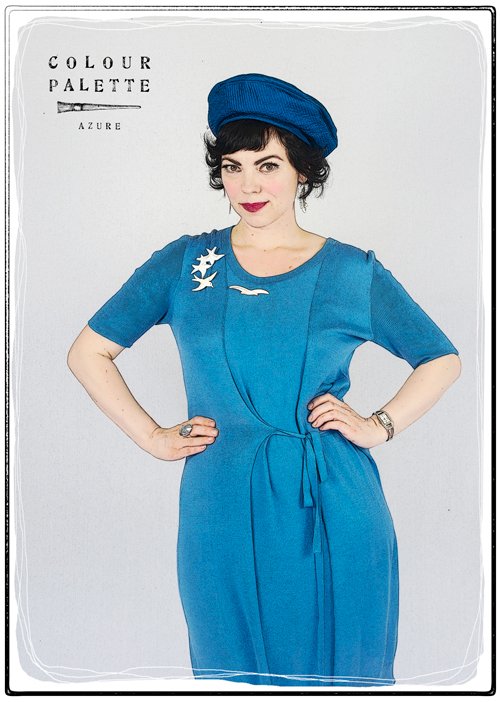 A modern dress with vintage 1950s hat and brooches from various erasThe colour azure is described as the colour of the sky on a clear day, but the origin of its name is in fact the blue mineral lapis lazuli. ‘Lapis’ is the Latin word for ‘stone’, and ‘lazuli’ is traced back through Medieval Latin, to the Arabic and ultimately to the Persian ‘lazaward’, which is the name of this stone in Persian, and also is the name of a place where the stone was mined.
A modern dress with vintage 1950s hat and brooches from various erasThe colour azure is described as the colour of the sky on a clear day, but the origin of its name is in fact the blue mineral lapis lazuli. ‘Lapis’ is the Latin word for ‘stone’, and ‘lazuli’ is traced back through Medieval Latin, to the Arabic and ultimately to the Persian ‘lazaward’, which is the name of this stone in Persian, and also is the name of a place where the stone was mined.
 Tumbled nuggets of lapis lazuli
Tumbled nuggets of lapis lazuli The Côte d'Azur
The Côte d'Azur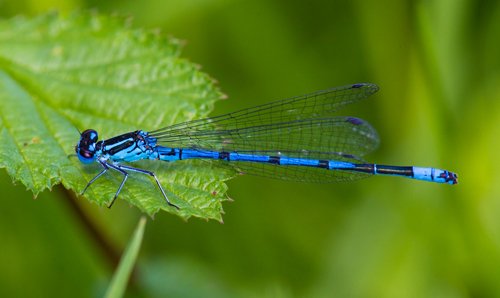 The azure damselflyDespite this generic meaning, the name of the stone became associated with the colour, assisted by its adoption in heraldry, where azure represented a blue colour in its system of tinctures. Many European languages subsequently adopted this root word, such as azur in French – whence comes the name of the Côte d’Azur – and the Italian azzurro, which also gives its name to the national football team.
The azure damselflyDespite this generic meaning, the name of the stone became associated with the colour, assisted by its adoption in heraldry, where azure represented a blue colour in its system of tinctures. Many European languages subsequently adopted this root word, such as azur in French – whence comes the name of the Côte d’Azur – and the Italian azzurro, which also gives its name to the national football team.
The colour is also seen in the plumage of many birds, kingfishers, hummingbirds, jays, and also in damsel- and dragonflies.
It is also – quite literally! – a divine colour to wear.
 A vintage 1960s dress and hat
A vintage 1960s dress and hat
Photos: November, September 2018
What is — and what is not — a fedora
THE DEFINITIVE GUIDE TO WHAT HAT IS THAT
 If you have been reading this blog for a little while, you will know that I love hats. While I am not a trained milliner, I do own a lot of hats (over 300) and books about hats, which I sometimes even read (as opposed to drooling over the pictures). I scour the internet for strange and wonderful hats, and for a long time I have been looking for the perfect 1930s or 1940s fedora. I already own one (pictured above), which I love for its film noir aspect, but I would love one more that has a more exaggerated shape, specifically in a colour I love (not black or brown, which are more ubiquitous).
If you have been reading this blog for a little while, you will know that I love hats. While I am not a trained milliner, I do own a lot of hats (over 300) and books about hats, which I sometimes even read (as opposed to drooling over the pictures). I scour the internet for strange and wonderful hats, and for a long time I have been looking for the perfect 1930s or 1940s fedora. I already own one (pictured above), which I love for its film noir aspect, but I would love one more that has a more exaggerated shape, specifically in a colour I love (not black or brown, which are more ubiquitous).
What I am finding however, is that vintage sellers seem to apply the word ‘fedora’ to any vaguely mannish hat, and I’m not sure if that’s because some of them aren’t really clear on the proper definition of a fedora, or because it is an extremely popular search term – I’ve seen it applied as a keyword for a frothy pink, flower-bedecked garden party hat! Today, however, I am going to clear up any misconceptions about what is – and what is not – a fedora, with a few key, easy-to-remember points to identify these same, same but different hats.
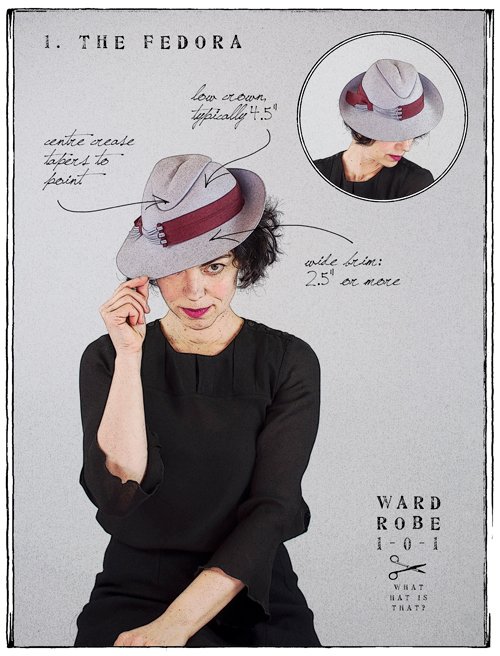 The Fedora
The Fedora
The fedora takes its name from an 1891 stage play, about a cross-dressing Princess Fedora who wears a centre-creased, soft wide-brimmed hat. Traditionally the crease is pinched at the front, forming a point or teardrop shape, but the crease can include diamond shaped crowns, and the positioning of dents can vary. Many other hats have centre dents, but the fedora combines this with a low crown – 4.5” or 11cm – and a wider brim of at least 2.5” or 6.4cm but they can be much wider, particularly in exaggerated fashion versions. The brims can be left raw, or stitched, or finished with ribbon-trim. This is the hat worn by Humphrey Bogart in the film Casablanca.
Key Points
- Low crown
- Centre crease pinched at front
- Wide brim
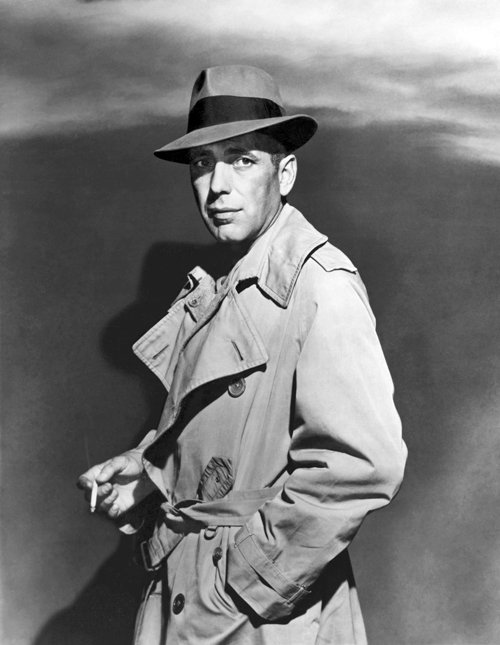 Humphrey Bogart in Casablanca; image found on Pinterest
Humphrey Bogart in Casablanca; image found on Pinterest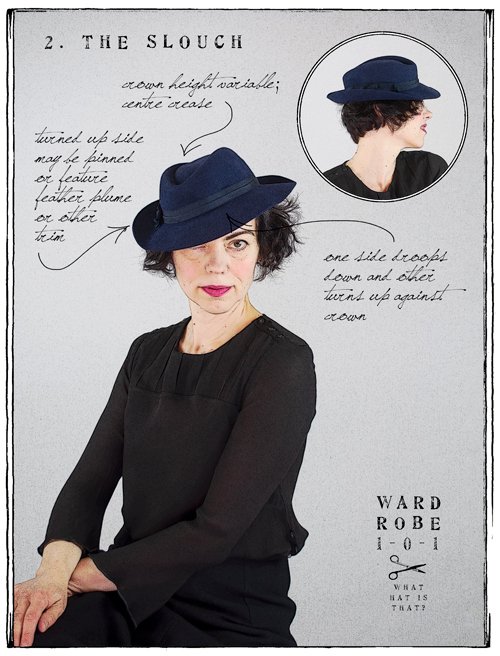
The Slouch
The next hat most commonly confused with a fedora, as far as I can discern, is the slouch hat. This is a style of hat traditionally worn by Australian soldiers (and those of many other nations), and is distinguished mainly with one side of the brim being turned up towards the crown, and one dipped down. The military hat has a fairly low crown, and the turned-up side is usually pinned to allow a rifle to be slung over the shoulder. Fashion versions vary in crown heights, but both feature a centre crease. Where the military hat is pinned up, the fashion hat may simply be decorated with trim on one side.
Key Points
- One side turned up, one side dipped down
- Crown height and brim width variable
- In place of the military pin, fashionable trim
 Australian soldier wearing a slouch in 1916; image found on Pinterest
Australian soldier wearing a slouch in 1916; image found on Pinterest
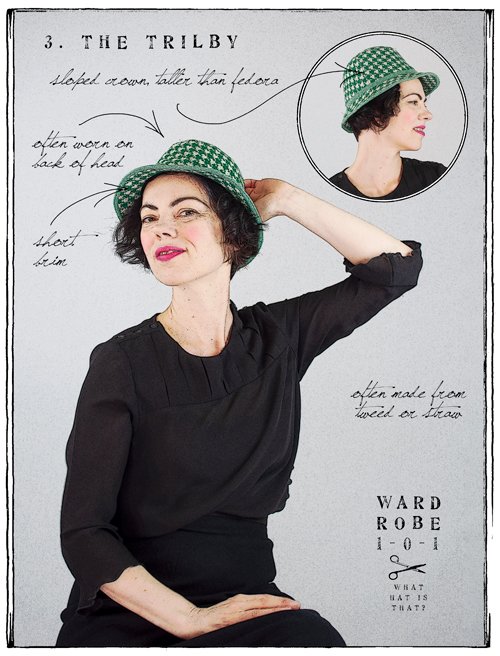 The Trilby
The Trilby
Another ubiquitous hat which can also be confused for a fedora is the trilby. Surprisingly, this is another hat whose inception lies in a stage play around the same time! George du Maurier’s 1894 novel Trilby was translated to the stage in London, and a hat of this shape was worn. Though the hat was worn by a woman, it became popular for men shortly after. It’s often made of tweed, like mine, or in straw for summer, though more properly its short brim is snapped up at the back. It has a much taller crown than a fedora, with sloped sides, and a popular hat with musicians, it is often worn on the back of the head. Sean Connery is well-known for wearing a trilby.
Key Points
- Short brim, usually snapped up at back
- Taller crown with sloping sides
- Designed to be worn further back on the head
 Sean Connery wearing a trilby; image found on Pinterest
Sean Connery wearing a trilby; image found on Pinterest
 The Homburg
The Homburg
The homburg is quite a masculine hat that has not really been translated into women’s versions, but this turquoise felt hat I own does not really fall into any other style, so I am using it to illustrate this style, perhaps most famously worn by Winston Churchill. Its most distinctive feature is the pencil-curled brim (which mine does not have at all). The hat is usually made of hard felt, with straight sides and a pronounced and quite wide centre crease. It is still a very popular hat shape for men today – and gangsters of all eras! Michael Corleone of The Godfather, and Nucky Thompson of Boardwalk Empire both present fine examples of the homburg’s sinister aspect.
Key Points
- Short, curled brim
- Taller crown with straight sides
- Wide, shallow centre crease
 Winston Churchill was famous for his homburg; image found on Pinterest
Winston Churchill was famous for his homburg; image found on Pinterest
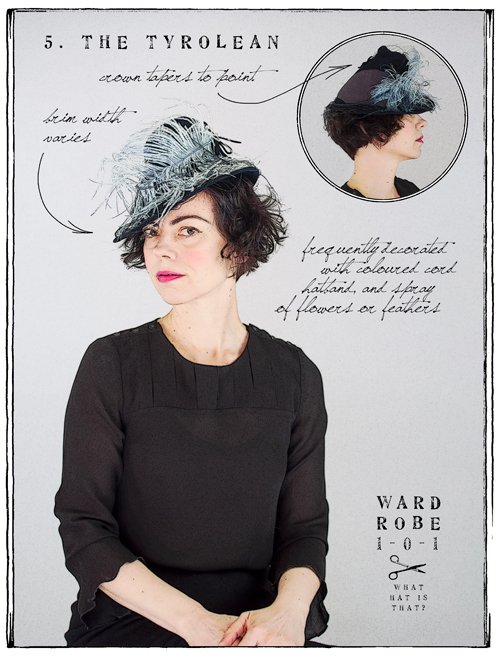
The Tyrolean
The Tyrolean hat style is one of my favourite jaunty styles! It originates from the Tyrol in the Alps, in what is now variously Austria, Germany, Italy and Switzerland. Its most distinctive feature is the crown that rises to form a point. The brim traditionally was roughly the width of a hand, and the hat was usually decorated with hatband made of coloured cord and a spray of flowers, feathers or brush. However, brims and crown heights varied in different parts of the Tyrol. Also known as a Bavarian or Alpine hat, it was originally made from green felt. Fortunately, fashion versions are not so limited in scope. Mine is navy, trimmed in a wide grosgrain band, netting, and a light blue ostrich feather. Edward VIII stayed in Austria after his abdication and often wore the hat, popularising its style.
Key Points
- Crown tapers to a point
- Crown height and brim width varies
- Decorated with flowers or feathers
 Edward VIII made the Tyrolean hat famous after his abdication
Edward VIII made the Tyrolean hat famous after his abdication
In Conclusion
Of course, it must be remembered that these key points are only guidelines for identifying a general style – they are not hard and fast rules. Fashion hats often take inspiration from traditional styles and designers will add their own twist, pushing and pulling them in exaggerated directions, creating hybrids with brilliant details and wonderful new ideas. A hat should be the exclamation point of an outfit, the finishing touch to delight the eye – much more than a conservative tradition. But it’s always good to know the rules before you break them.
Photos: September 2019
Hybird
 I love a little word-punning! This cute beaded and sequinned parrot is a hybrid brooch and hairclip, which I have dubbed a clooch … I fully expect that word to take off and quickly become ubiquitous in the sartorial lexicon.
I love a little word-punning! This cute beaded and sequinned parrot is a hybrid brooch and hairclip, which I have dubbed a clooch … I fully expect that word to take off and quickly become ubiquitous in the sartorial lexicon.
I found this clooch in the jewellery boutique, Lovisa, and was taken with it because I love birds in general. I am yet to wear it, but will more likely do so as a brooch than a hairclip, since I wear hats all the time. Additional bonus: it was $6 on sale, very cheep-cheep!
Photo: September 2019
The Tie Cuff
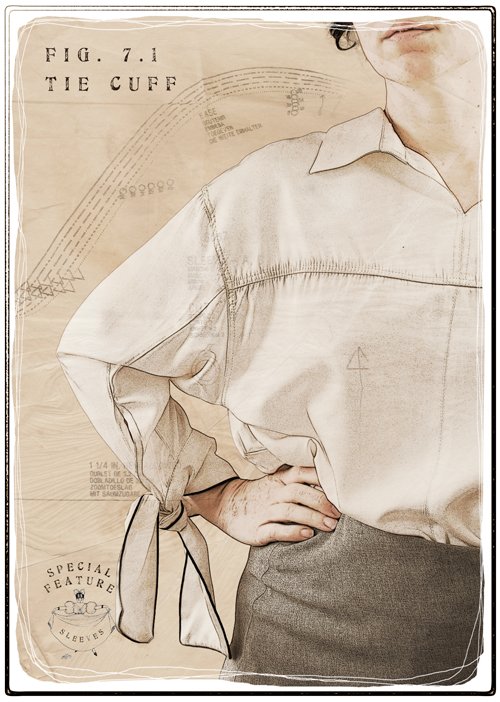
Long cuffs that fasten with a knot or bow, or ‘tie cuffs’ as I have dubbed them, add a decorative element to what may be an otherwise ordinary sleeve. But if you have never sported a tie cuff, be warned: unsuspected dangers lurk in these knotty waters!
The dropped shoulder of this long sleeve belongs to a rather dramatic, billowy blouse that features very large and long tie cuffs. The first time I wore this blouse I immediately knew why I had found it at the thrift store. While the fabric is soft, it is quite substantial, and the cuff takes the form of long, wide ties, accentuated by black piping, that are knotted at the wrist. As the sleeves are quite wide too, I took care to knot them so that the ties fell on the outside of the hand.
The ties were disconcerting at first, a hindrance until I allowed gravity to drag at the weight of the knots to keep them out my way while using my computer keyboard at work. I also discovered another hazard at lunchtime: because of the heavy, floppy ties, I managed to splash a bit of my curry laksa soup on the cuff (fortunately I was able to wash it out). This blouse is clearly for those who thumb their nose at sartorial danger, and it was admired by my work colleagues.

… if you have never sported a tie cuff, be warned: unsuspected dangers lurk in these knotty waters!
Three-quarter sleeves, such as on this striped blouse with its set-in sleeves, are a more sensible design choice combined with dangling tie cuffs. This cotton fabric (adorably striped like traditional ticking, which I love) is much lighter as well, so the ties pose no danger.
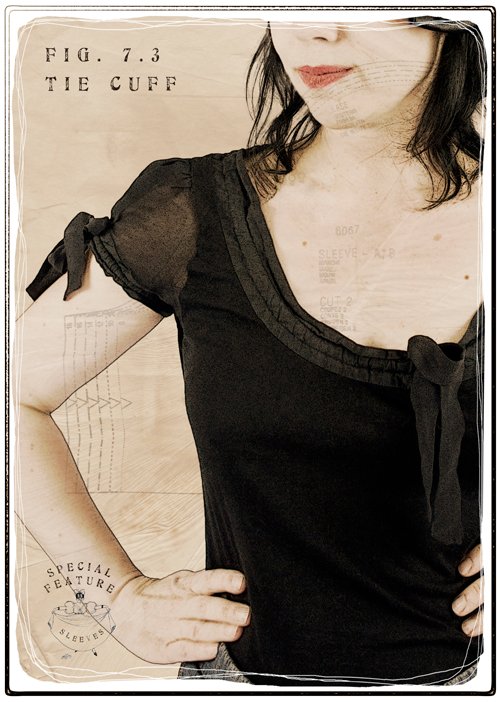
The puff sleeves, also set-in, of this cotton modal and silk tee have silk chiffon ties – lighter still – which are long and thin enough to tie into bows: both decorative and too short to interact perilously with the environment. An asymmetrically-placed bow at the neckline combined with the two sleeve bows create a pretty and overtly feminine top.
Three styles of tie-cuffs, three very different effects with various danger levels: from big drama, to breezy and casual, to whimsical femininity.
Review all the sleeves in the gallery thus far.


